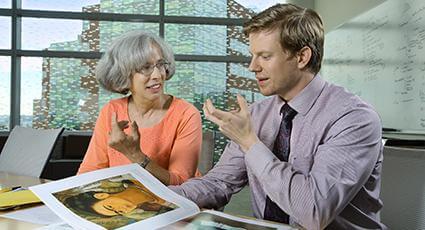
Physicians and nurses, among others in health care, live in a world of stories—and they and their patients are the storytellers. Each day they reveal new narratives immersed in illness and injury, pain and suffering, symptoms and diagnoses, treatments and cures—and sometimes end-of-life issues rather than cures. What do these health professionals do with the stories? Do they disregard them and move on to the next patient? Or infuse them into their daily working lives to improve patient care? If so, how?
Such questions are at the root of “AfterWards,” a new narrative medicine program at Johns Hopkins designed to illuminate stories of healing for the healers. The brainchild of Johns Hopkins pediatric resident Ben Oldfield (above, right) and University of Maryland English professor Lauren Small (above, left), AfterWards is designed to connect caregivers in more intimate ways to the human story underlying the disease—and, consequently, in more intimate ways to the patient’s experience. But to find the therapeutic value, Oldfield explains, caregivers must learn how to recognize and metabolize stories of illness.
“Effective medicine requires narrative competence, or the ability to acknowledge, absorb, interpret and act on the stories and plights of others,” says Oldfield. “Recognizing the narratives important in your patients can empower you to understand the illness experience and help generate resilience in the face of adversity.”
Each AfterWards session, held monthly in the Johns Hopkins Children’s Center, comes with a theme like “bearing witness to suffering” or “stories behind the illness” and an accompanying narrative from which to explore that theme. But Oldfield and Small have defined narrative as more than the printed word—a painting, photograph or sculpture, as well as a piece of literary fiction or a poem, will do. At a recent session, for instance, the work of Mexican artist Frida Kahlo was appraised by staff physicians, residents, nurses and social workers. What they found was a brief and isolated life plagued by painful injuries—including a shattered spinal column, a broken collarbone and ribs, a broken pelvis, and 11 fractures in her right leg from a horrific bus accident—and chronic illness and emotional distress during her turbulent marriage and subsequent divorce to fellow artist Diego Rivera. Perhaps unable to express her painful experiences in words, Kahlo played hers out in surreal but raw and revealing self-portraits.
“How do we understand and assess pain?” Small asked AfterWards participants. “Something about pain puts it beyond words, beyond expression.”
Pointing to a self-portrait portraying two Frida Kahlos—one in emotional pain and one in physical pain—Small added, “What strikes me about this is the doubling of her identities. When someone is in pain, all they can think about is that pain. They lose sight of their identity as a healthy person.”
The benefit of such art for the healers?
“We can all project our own experiences onto it,” says pediatric adolescent fellow Deanna Wilson. “You cannot divorce yourself from it—how you perceive it is colored by your previous experiences.”
Indeed, after reviewing such artwork and the artists’ underlying lives, AfterWards participants are asked to write their own reflections about the theme in their lives as both caregivers and patients. A physician wrote about pain as a “mind out of body” experience, another about difficulty in deciding how much pain medicine to administer to a terminal patient, and another about the unexpected cardiac arrest and the first death of a child she witnessed on her unit. “I can still hear the mom sobbing, see the pain on everyone’s face,” she wrote.
“We often think of pain in a very biomedical way, the physiological processes going on and how to treat the pain,” says Wilson. “Here we can focus more on the patient’s emotional experience, which gives us a much broader understanding of what it’s like for the individual. That contextualizes the experience and helps you understand that pain is not separate from other things going on in the patient’s life.”
Such self-reflections, Wilson adds, may also counter the inherent stress that comes with caring for patients, and so-called “physician burnout.”
“Reflecting on our experiences allows better clarity, helps us process our experiences and emotions, which allows us to give more of ourselves to our patients,” says Wilson. “Reflection also allows us to see that our colleagues have similar emotions, and in seeing our common threads we all might approach the care of our patients in different and more effective ways.”
##
